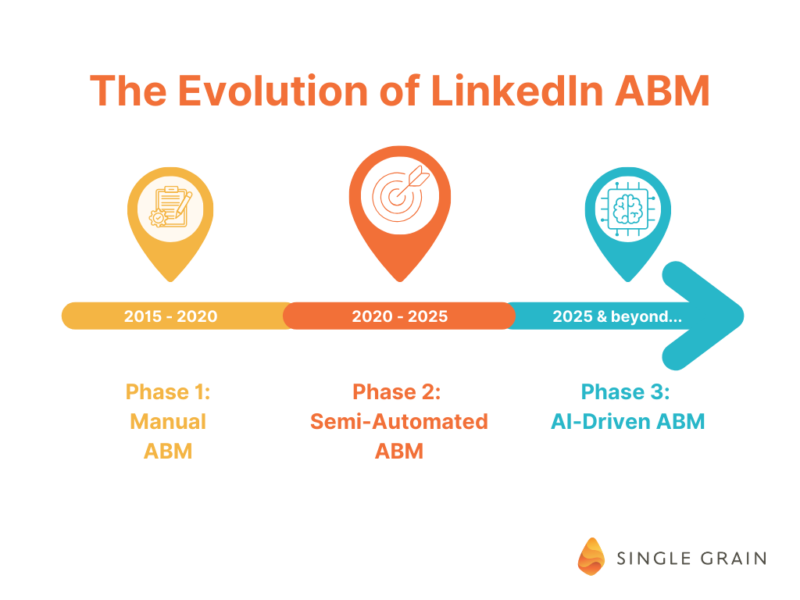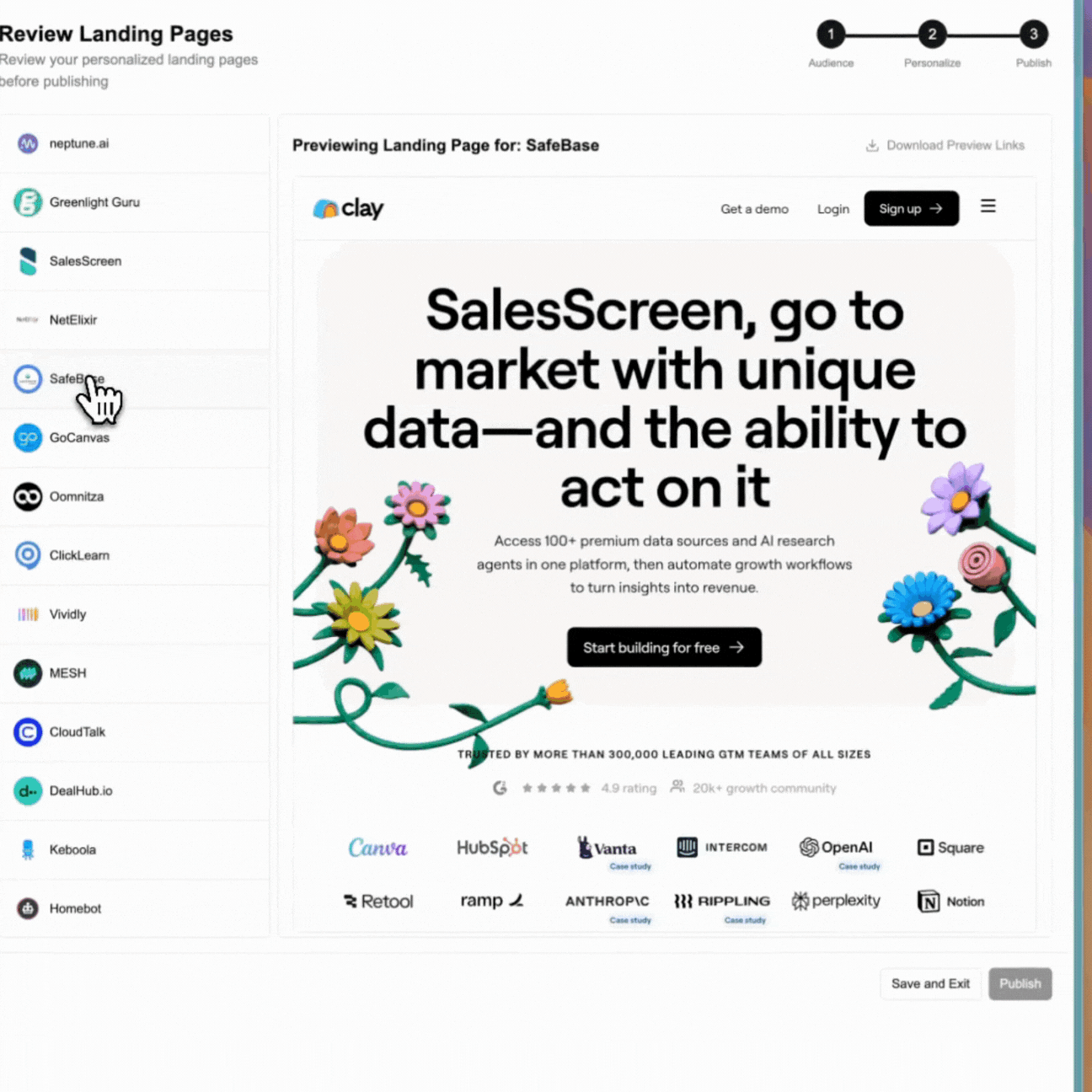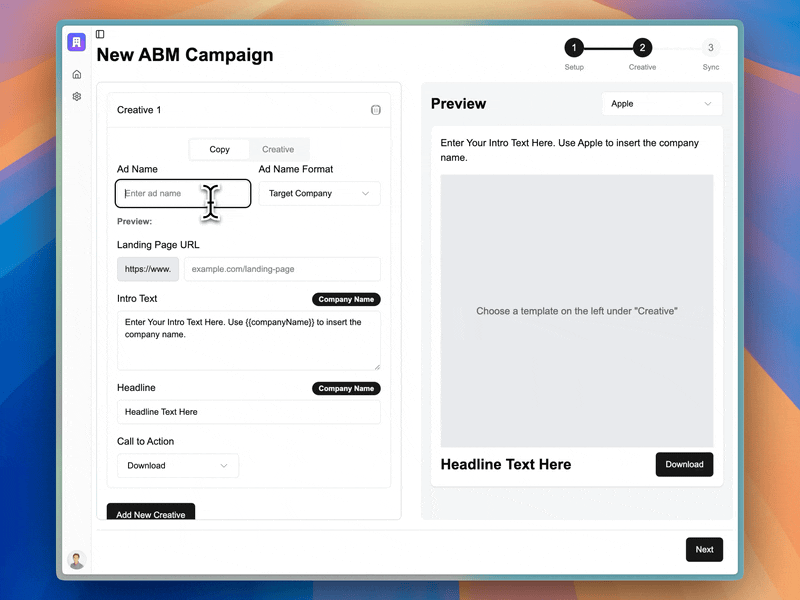The LinkedIn advertising landscape is undergoing a profound transformation, driven by rapid advancements in artificial intelligence and machine learning technologies. As we look toward the future, AI-driven innovations will revolutionize how B2B marketers approach Account-Based Marketing (ABM) on the platform.
While traditional LinkedIn ABM campaigns have delivered impressive results, the next generation of AI-powered approaches promises to take personalization, efficiency, and performance to unprecedented levels. By understanding these emerging trends and technologies, forward-thinking marketers can gain a significant competitive advantage in the evolving LinkedIn advertising ecosystem.
Key Highlights
- AI-driven ABM innovations are expected to dominate LinkedIn advertising strategies in 2025 and beyond
- 97% of marketers report that ABM delivers a higher return on investment than other marketing strategies
- Hyper-personalization at scale will become the new standard for LinkedIn ABM campaigns
- Predictive analytics will transform target account selection with up to 70% greater accuracy
- AI-generated creative will enable true 1-1 personalization across thousands of accounts
- Autonomous campaign optimization will continuously refine targeting and messaging
- Integrated intelligence platforms like Karrot.ai will provide end-to-end ABM automation
- Privacy-centric personalization will balance personalization with evolving data regulations
TABLE OF CONTENTS:
The Evolution of LinkedIn ABM
Account-based marketing has transformed B2B marketing, with 70% of marketers now having active ABM programs in place. LinkedIn has emerged as the premier platform for ABM execution due to its professional focus and robust targeting capabilities.

The evolution of LinkedIn ABM can be understood in three distinct phases:
Phase 1: Manual ABM (2015-2020)
The first generation of LinkedIn ABM relied heavily on manual processes:
- Basic account targeting through LinkedIn’s native tools
- Limited personalization capabilities
- Manual campaign management and optimization
- Rudimentary measurement and attribution
Phase 2: Semi-Automated ABM (2020-2025)
The current generation introduced partial automation:
- Enhanced targeting through LinkedIn’s Matched Audiences
- Template-based personalization approaches
- Rule-based campaign optimization
- Multi-touch attribution models
Phase 3: AI-Driven ABM (2025 and Beyond)
The emerging future state leverages advanced AI:
- Predictive account identification and prioritization
- Hyper-personalization through generative AI
- Autonomous campaign optimization
- Closed-loop intelligence systems
This evolution represents a fundamental shift from human-directed campaigns to AI-augmented and, eventually, AI-orchestrated approaches. Recent data shows that early adopters of AI-driven LinkedIn ABM are seeing 35-45% performance improvements over traditional approaches.
Trend 1: Predictive Account Intelligence
The foundation of future LinkedIn ABM will be AI-powered account intelligence that goes far beyond current targeting capabilities:
From Reactive to Predictive Targeting
Traditional ABM relies on historical data and basic firmographics to identify target accounts. Future approaches will use predictive models to identify:
- Accounts showing early buying signals before explicit intent
- Companies likely to experience trigger events that create needs
- Organizations with the highest propensity to convert based on complex pattern recognition
- Ideal engagement planning based on predicted buying windows
Predictive analytics will transform target account selection with up to 70% greater accuracy compared to traditional methods, ensuring marketing resources are focused on accounts with the highest likelihood of conversion.
Dynamic Account Prioritization
Beyond initial selection, AI will continuously reprioritize accounts based on:
| Signal Type | Data Sources | AI Application |
|---|---|---|
| Engagement Signals | LinkedIn activity, website behavior, email interactions | Pattern recognition to identify buying intent |
| Market Signals | News events, funding announcements, executive changes | Natural language processing to detect opportunity triggers |
| Competitive Signals | Competitor interactions, technology evaluations | Comparative analysis to identify competitive opportunities |
| Timing Signals | Historical purchase patterns, budget cycles | Temporal modeling to predict optimal engagement timing |
This dynamic prioritization ensures that marketing resources are continuously allocated to the accounts with the highest conversion potential at any given moment.
Trend 2: Hyper-Personalization Through Generative AI
The next frontier in LinkedIn ABM is hyper-personalization powered by generative AI:
From Template-Based to Generated Creative
Current personalization approaches rely on templates with variable fields. Future approaches will use generative AI to create truly unique creative for each account:
- AI-generated visuals that incorporate account-specific imagery and branding
- Dynamic copy generation tailored to each account’s specific challenges and opportunities
- Personalized video content featuring account-specific data and scenarios
- Interactive experiences customized for each target account
Companies implementing early versions of AI-generated creative for LinkedIn ads report conversion rate improvements of up to 80% compared to template-based approaches.
Contextual Personalization
Beyond account-level personalization, AI will enable contextual personalization based on:
- The specific user viewing the ad
- The time and device being used
- Recent interactions with your brand
- Current events relevant to the account
- Competitive activities and market dynamics
This contextual layer ensures that personalization goes beyond simply inserting a company name to delivering truly relevant experiences based on the complete engagement context.
The Karrot.ai Advantage

Platforms like Karrot.ai are at the forefront of this transformation, using advanced AI to:
- Generate personalized creative at scale without templates
- Continuously optimize messaging based on performance data
- Adapt creative elements based on account-specific context
- Maintain brand consistency while enabling true personalization
This approach eliminates the traditional tradeoff between personalization and scale, allowing marketers to deliver hyper-personalized experiences to thousands of accounts simultaneously.
Trend 3: Autonomous Campaign Optimization
Future LinkedIn ABM campaigns will leverage AI for continuous, autonomous optimization:
Self-Optimizing Campaigns
Rather than requiring manual adjustments, AI-driven campaigns will:
- Automatically adjust targeting parameters based on performance
- Reallocate budget across audience segments in real-time
- Optimize bidding strategies at the account level
- Refine creative elements based on engagement patterns
- Adjust messaging based on competitive activities
This autonomous optimization will occur continuously rather than at predetermined intervals, ensuring campaigns are always operating at peak performance.
Predictive Performance Modeling
AI will enable predictive performance modeling that:
- Forecasts expected performance across different account segments
- Identifies potential performance issues before they impact results
- Recommends proactive optimizations to improve outcomes
- Simulates the impact of different optimization approaches
This predictive capability allows marketers to make informed decisions about campaign strategy based on likely outcomes rather than reacting to past performance.
Trend 4: Integrated Intelligence Platforms
The future of LinkedIn ABM will be powered by integrated intelligence platforms that connect all aspects of the ABM lifecycle:
End-to-End ABM Orchestration
Platforms like Karrot.ai will evolve to provide comprehensive orchestration:
- Account Intelligence: Predictive identification and prioritization
- Audience Development: AI-powered segmentation and targeting
- Creative Generation: Hyper-personalized content creation
- Campaign Execution: Automated deployment across channels
- Performance Optimization: Continuous, autonomous improvement
- Measurement and Attribution: Closed-loop performance tracking
This integrated approach eliminates the current fragmentation between different ABM tools and processes, creating a seamless workflow from account selection to revenue attribution.
Cross-Channel Coordination
Future LinkedIn ABM will be tightly coordinated with other channels:
- Synchronized messaging across LinkedIn, email, and other platforms
- Cross-channel engagement tracking for unified customer experience
- Channel optimization based on account preferences and behavior
- Integrated measurement across all touchpoints
This coordination ensures that LinkedIn campaigns are part of a cohesive account experience rather than isolated interactions.
Trend 5: Privacy-Centric Personalization
As privacy regulations evolve, future LinkedIn ABM will balance personalization with privacy:
First-Party Data Activation
Future approaches will prioritize first-party data:
- CRM integration for privacy-compliant personalization
- Account-level insights that don’t rely on individual tracking
- Contextual targeting based on content and environment
- Permission-based personalization that respects user preferences
This approach ensures that personalization remains effective even as third-party data becomes less available.
Ethical AI Frameworks
Leading platforms like Karrot.ai are developing ethical AI frameworks that:
- Ensure transparency in how personalization decisions are made
- Provide controls for users to manage their personalization preferences
- Avoid potentially biased or discriminatory targeting approaches
- Balance personalization effectiveness with privacy considerations
These frameworks will be essential for maintaining user trust while delivering personalized experiences.
Trend 6: Immersive and Interactive Ad Experiences
The future of LinkedIn advertising will move beyond static formats to immersive experiences:
Interactive Ad Formats
Next-generation LinkedIn ads will include:
- Interactive product demos customized for each account
- Personalized assessment tools that provide immediate value
- Conversational ad experiences powered by AI
- Augmented reality elements that bring solutions to life
These interactive formats drive significantly higher engagement than traditional ads, with early adopters reporting 2-3X improvements in key metrics.
In-Ad Conversion Paths
Future LinkedIn ads will enable complete conversion journeys without leaving the platform:
- In-ad forms pre-populated with known information
- Scheduling capabilities for direct meeting booking
- Content selection for personalized resource delivery
- Chatbot integration for immediate question answering
This streamlined approach removes friction from the conversion process, improving both user experience and conversion rates.
Case Study: Early Adopter Leverages AI-Driven LinkedIn ABM
A B2B software company implemented an early version of AI-driven LinkedIn ABM targeting 1,000 enterprise accounts. Using Karrot.ai’s advanced AI capabilities, they:
- Deployed predictive account scoring to identify high-potential targets
- Generated personalized creative for each account using generative AI
- Implemented autonomous optimization across all campaign elements
- Coordinated LinkedIn campaigns with email and sales outreach
The results demonstrated the power of this approach:
- 215% increase in target account engagement
- 78% improvement in MQL-to-opportunity conversion
- 52% reduction in cost-per-acquisition
- 4.1X return on ad spend
- $18.7M in influenced pipeline within 6 months
Preparing for the AI-Driven LinkedIn ABM Future
To position your organization for success in this evolving landscape:
Strategic Preparation
- Audit your data foundation to ensure you have the necessary inputs for AI-driven approaches
- Develop an AI readiness roadmap for your marketing organization
- Identify pilot opportunities to test emerging capabilities
- Build cross-functional teams that combine marketing, data science, and technology expertise
Technology Evaluation
- Assess current ABM technology against future requirements
- Identify gaps in your existing technology stack
- Evaluate emerging platforms like Karrot.ai that offer integrated AI capabilities
- Develop a phased implementation plan for new technologies
Skill Development
- Identify key AI literacy requirements for marketing teams
- Develop training programs to build necessary capabilities
- Consider hiring specialized talent in AI marketing applications
- Create collaborative models between marketing and data science teams
Conclusion
The future of LinkedIn advertising will be defined by AI-driven ABM innovations that transform how B2B marketers identify, engage, and convert high-value accounts. By embracing predictive intelligence, hyper-personalization, autonomous optimization, and integrated platforms, marketers can achieve unprecedented levels of performance and efficiency.
With 97% of marketers reporting that ABM delivers a higher ROI than other marketing strategies, the investment in AI-driven approaches is well justified. The key is starting now to build the foundation for these capabilities before they become table stakes in the competitive LinkedIn advertising landscape.
As you prepare for this AI-driven future, consider how platforms like Karrot.ai can accelerate your journey by providing integrated intelligence and automation capabilities. By combining the power of AI with your marketing expertise, you can create LinkedIn ABM campaigns that deliver exceptional results today while positioning you for the innovations of tomorrow.




